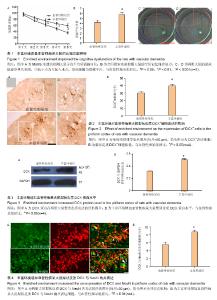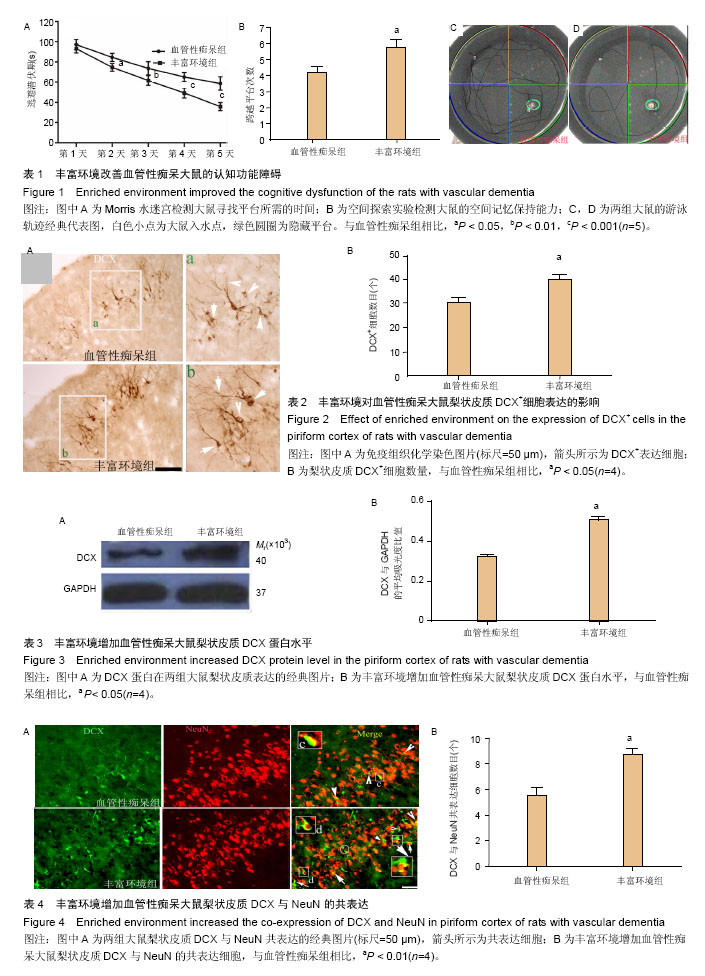| [1] Couillard-Despres S, Winner B, Schaubeck S, et al. Doublecortin expression levels in adult brain reflect neurogenesis. Eur J Neurosci. 200;21(1):1-14.
[2] Iadecola C. The pathobiology of vascular dementia. Neuron. 2013;80(4):844-866.
[3] Nithianantharajah J, Hannan AJ. Enriched environments, experience-dependent plasticity and disorders of the nervous system. Nat Rev Neurosci. 2006;7(9):697-709.
[4] 季力,崔晓.丰富环境对脑神经可塑性的影响[J].神经病学与神经康复学杂志,2013, 10(2): 99-101.
[5] 赵晖,王少烽,张秋霞,等.丰富环境干预对慢性低灌注血管性痴呆大鼠学习记忆及突触素蛋白和微管相关蛋白的影响[J].中国康复医学杂志,2012, 27(8): 687-691.
[6] 隋南,翁旭初,高扬,等.梨状皮层或苍白球损毁对大鼠空间认知能力的影响[J].心理学报,1995,27(4): 428-433.
[7] 刘圆月,侯菊花,刘伏祥,等.建立嗅觉剥夺模型观察嗅觉活动调节成年豚鼠梨状皮质神经元的表达[J]. 中国组织工程研究, 2015, 19(18): 2867-2873.
[8] He X, Zhang XM, Wu J, et al. Olfactory experience modulates immature neuron development in postnatal and adult guinea pig piriform cortex. Neuroscience. 2014;259:101-112.
[9] 蔡晶,杜建.血管性痴呆动物模型的制作方法及其评价[J].中医药学刊,2002, 20(5): 617-618.
[10] 黄文革,郭芬芬,刘慰华,等.血管性痴呆动物模型制作方法的改良[J].中国比较医学杂志,2011,21(5): 49-52.
[11] Jiwa NS, Garrard P, Hainsworth AH. Experimental models of vascular dementia and vascular cognitive impairment: a systematic review. J Neurochem. 2010; 115(4):814828.
[12] 赵勇,崔淑芳,汤球.血管性痴呆动物模型研究进展[J].上海实验动物科学,2005, 25(1): 54-58.
[13] 曾贵刚,李峻,彭海东,等.大鼠血管性痴呆动物模型的研究进展[J].中国比较医学杂志,2012,22(3): 50-55.
[14] 李国春,黄新武,张红,等.不同时点分别结扎左、右颈总动脉建立的大鼠血管性痴呆模型血流变学及生化学研究[J].现代预防医学,2011, 38(4): 718-720.
[15] 乔晓鸣,任世存.血管性痴呆模型大鼠接受沙棘总黄酮后血清肿瘤坏死因子α及白细胞介素1β的表达[J].中国组织工程研究,2014,18(36): 5819-5824.
[16] 陆澄秋,钟乐,颜崇淮,等.丰富环境对神经发生影响的研究进展[J].国际神经病学神经外科学杂志,2007, 34(5): 474-477.
[17] Bayat M, Sharifi MD, Haghani M, et al. Enriched environment improves synaptic plasticity and cognitive deficiency in chronic cerebral hypoperfused rats. Brain Res Bull. 2015;119(Pt A):34-40.
[18] van Praag H, Kempermann G, Gage FH. Neural consequences of environmental enrichment. Nat Rev Neurosci. 2000;1(3):191-198.
[19] Rubio A, Belles M, Belenguer G, et al. Characterization and isolation of immature neurons of the adult mouse piriform cortex. Dev Neurobiol. 2015 Oct 21. [Epub ahead of print]
[20] Shakhawat AM, Gheidi A, MacIntyre IT, et al. Arc-Expressing Neuronal Ensembles Supporting Pattern Separation Require Adrenergic Activity in Anterior Piriform Cortex: An Exploration of Neural Constraints on Learning. J Neurosci. 2015;35(41): 14070-14075.
[21] 林俏明,范玉华,李妙嫦.丰富环境对血管性痴呆大鼠学习记忆和海马区BDNF、TrkB表达的影响[J]. 广东医学院学报,2015,33(2): 147-150.
[22] Gleeson JG, Lin PT, Flanagan LA, et al. Doublecortin is a microtubule-associated protein and is expressed widely by migrating neurons. Neuron. 1999;23(2): 257-271.
[23] Couillard-Despres S, Winner B, Schaubeck S, et al. Doublecortin expression levels in adult brain reflect neurogenesis. Eur J Neurosci. 2005;21(1):1-14.
[24] Francis F, Koulakoff A, Boucher D, et al. Doublecortin is a developmentally regulated, microtubule- associated protein expressed in migrating and differentiating neurons. Neuron. 1999;23(2): 247-256.
[25] Fan CL,Zhang MQ,Shang L,et al.Short-term environmental enrichment exposure induces proliferation and maturation of doublecortin-positive cells in the prefrontal cortex. Neural Regen Res. 2014; 9(3): 318-328.
[26] Koizumi H, Higginbotham H, Poon T, et al. Doublecortin maintains bipolar shape and nuclear translocation during migration in the adult forebrain. Nat Neurosci. 2006;9(6):779-786.
[27] Brown JP, Couillard-Després S, Cooper-Kuhn CM, et al. Transient expression of doublecortin during adult neurogenesis. J Comp Neurol. 2003;467(1):1-10. |

